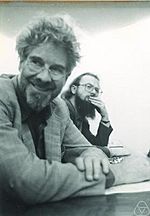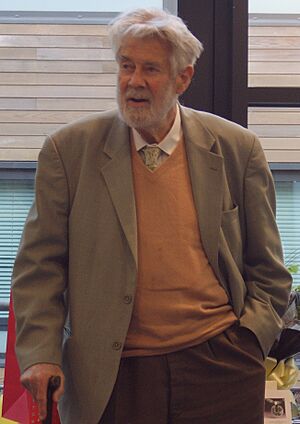Christopher Zeeman facts for kids
Quick facts for kids
Sir
Christopher Zeeman
|
|
|---|---|

Erik Christopher Zeeman in 1980, courtesy MFO
|
|
| Born |
Erik Christopher Zeeman
4 February 1925 Japan
|
| Died | 13 February 2016 (aged 91) Woodstock, England
|
| Citizenship | British |
| Alma mater | Christ's College, Cambridge |
| Known for | Catastrophe theory Geometric topology Singularity theory Zeeman conjecture Zeeman's comparison theorem Stallings–Zeeman theorem |
| Awards | Senior Whitehead Prize (1982) Faraday Medal (1988) David Crighton Medal (2006) |
| Scientific career | |
| Fields | Mathematics |
| Institutions | University of Cambridge University of Warwick University of Oxford Gresham College |
| Thesis | Dihomology (1955) |
| Doctoral advisor | Shaun Wylie |
| Doctoral students | Peter Buneman David Epstein Ray Lickorish Tim Poston Colin Rourke David Trotman Terry Wall Jenny Harrison |
| Notes | |
Sir Erik Christopher Zeeman (born February 4, 1925 – died February 13, 2016) was a brilliant British mathematician. He was especially known for his work in geometric topology and singularity theory. These are advanced areas of mathematics that study shapes and how they change.
Contents
Understanding Zeeman's Math Contributions
Zeeman made big contributions to a field called topology. Topology is like the study of shapes that can be stretched or bent without tearing. Imagine a donut and a coffee cup; to a topologist, they are the same shape!
Exploring Knot Theory
One area he worked on was knot theory. This part of topology studies mathematical knots. These are like the knots you tie in a shoelace, but in a more abstract, mathematical way.
Discovering Catastrophe Theory
Zeeman also helped make catastrophe theory famous. This theory, first developed by another mathematician named René Thom, looks at how small, smooth changes in one thing can lead to sudden, big changes in another. It's used to understand sudden shifts, like how a bridge might suddenly collapse or how an animal's behavior might suddenly change.
Applying Math to Real Life
He was very keen on using mathematics, especially catastrophe theory, to understand things in biology and how people behave. He believed math could help explain many real-world situations.
Zeeman's Early Life and Education
Christopher Zeeman was born in Japan. His father was Danish, and his mother was British. When he was just one year old, his family moved to England.
School and Military Service
He went to school at Christ's Hospital in West Sussex. During World War II, from 1943 to 1947, he served as a Flying Officer in the Royal Air Force. This meant he was a pilot!
Studying at Cambridge
After the war, he went to Christ's College, Cambridge to study mathematics. He had forgotten a lot of his school math during his time in the air force, but he quickly caught up. He earned his PhD from the University of Cambridge.
Zeeman's Amazing Academic Journey
After his studies, Zeeman worked at Cambridge and spent time in the United States. He was a Harkness Fellow at the University of Chicago and Princeton University.
Founding Warwick's Math Department
In 1964, he did something really special. He founded the Mathematics Department and a research center at the new University of Warwick. He was 38 years old and had clear ideas about how to create a great math department. He wanted it to be flexible like American universities but also offer the personal teaching found at Oxford and Cambridge.
Building a World-Class Team
Zeeman was an inspiring leader. He quickly made Warwick's math department famous around the world for its excellent research. He first hired top experts in topology, then in other areas like algebra and applied mathematics.
Teaching and Research
From 1966 to 1967, he was a visiting professor at the University of California, Berkeley. This is where he became very interested in dynamical systems. These systems study how things change over time, like the weather or the movement of planets.
Sharing Catastrophe Theory
He later spent time with René Thom in Paris, which deepened his interest in catastrophe theory. When he returned to Warwick, he taught a course on it that was incredibly popular. His lectures were always packed with students!
Awards and Recognition
Zeeman received many honors for his work. In 1975, he became a Fellow of the Royal Society, which is a very prestigious group of scientists. He also won the Society's Faraday Medal in 1988.
Leading Mathematical Societies
He was the President of the London Mathematical Society from 1986 to 1988. He also gave special lectures in New Zealand as the Society's first Forder lecturer. From 1988 to 1994, he was a Professor of Geometry at Gresham College.
Inspiring Young Minds
In 1978, Zeeman gave the famous televised Royal Institution Christmas Lectures. These lectures were designed to make science exciting for young people. From these lectures, he helped create the Mathematics and Engineering Masterclasses. These classes now help many primary and secondary school children across the UK learn about math.
Later Career and Knighthood
In 1988, Zeeman became the Principal of Hertford College, Oxford. In 1991, he was made a knight by the Queen for his amazing contributions to mathematics and math education in Britain. This is why he is called "Sir" Christopher Zeeman.
Lasting Legacy
In 2005, a new building at the University of Warwick was named the Zeeman building in his honor. In 2006, he received the David Crighton medal for his long and important service to mathematics. Sir Christopher Zeeman passed away on February 13, 2016.
The Christopher Zeeman Medal
The Christopher Zeeman Medal for Communication of Mathematics is named after him. It's given by the London Mathematical Society and the Institute of Mathematics and its Applications. This award honors mathematicians who are great at sharing their love of math with the public. They could be university professors, school teachers, or mathematicians working in other fields.
See also
- Mary Lou Zeeman, Zeeman's daughter, who is also a mathematician.
- Nicolette Zeeman, Zeeman's daughter, who is a literary scholar.


